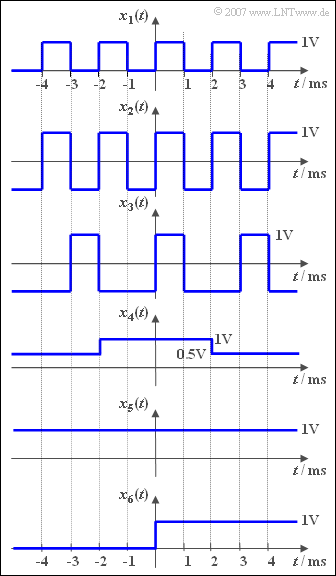Exercise 2.2: DC Component of Signals
From LNTwww
The graph shows six time signals defined for all times (from −∞ to +∞). For all sample signals xi(t) the associated spectral function can be written as:
- Xi(f)=A0⋅δ(f)+ΔXi(f).
Here:
- A0 is the DC component of the signal.
- ΔXi(f) is the spectrum of the residual signal reduced by the DC component:
- Δxi(t)=xi(t)−A0.
Hint:
- This exercise belongs to the chapter
Direct Current Signal - Limit Case of a Periodic Signal.
Questions
Solution
(1) The correct answers are 1, 3, 4, 5 and 6.
- All signals except x2(t) contain a DC signal component.
(2) Only solution 5 is correct:
- If the DC component 1V is subtracted from the signal x5(t), the residual signal Δx5(t)=x5(t)−1V is zero.
- Accordignly, the spectral function is ΔX5(f)=0.
- For all other time courses \Delta x_i(t)ßne 0 and thus the associated spectral function \Delta X_i(f)\ne 0, too.
(3) Given a periodic signal, averaging over a period duration is sufficient to calculate the DC signal component A_0 .
- For signal x_3(t) the period duration is T_0 = 3\,\text{ms}. This results in the required DC component:A_0=\rm \frac{1}{3\,ms}\cdot \big[1\,V\cdot 1\,ms+(-1\,V)\cdot 2\,ms \big] \hspace{0.15cm}\underline{=-0.333\,V}.
(4) The signal x_4(t) can be written as: x_4(t) = 0.5 \,{\rm V} + Δx_4(t).
- Here Δx_4(t) denotes a rectangular pulse with amplitude 0.5 \,{\rm V} and duration 4 \,{\rm ms} ,
- which due to its finite duration does not contribute to the DC signal component.
- Therefore A_0 \hspace{0.15cm}\underline{=0.5 \,{\rm V}} applies here.
(5) The general equation for calculating the DC signal component is:
- A_0=\lim_{T_{\rm M}\to \infty}\frac{1}{T_{\rm M}}\int_{-T_{\rm M}/2}^{+T_{\rm M}/2}x(t)\, {\rm d }t.
- If one splits this integral into two partial integrals, one obtains:
- A_0=\lim_{T_{\rm M}\to \infty}\frac{1}{T_{\rm M}}\int _{-T_{\rm M}/2}^{0}0 {\rm V} \cdot\, {\rm d } {\it t }+\lim_{T_{\rm M}\to \infty}\frac{1}{T_{\rm M}}\int _{0}^{+T_{\rm M}/2}1 \rm V \ {\rm d }{\it t }.
- Only the second term makes a contribution. From this follows again : A_0 \hspace{0.15cm}\underline{=0.5 \,{\rm V}}.
